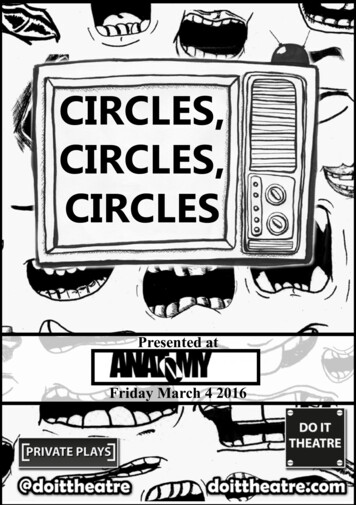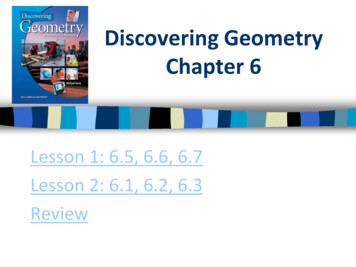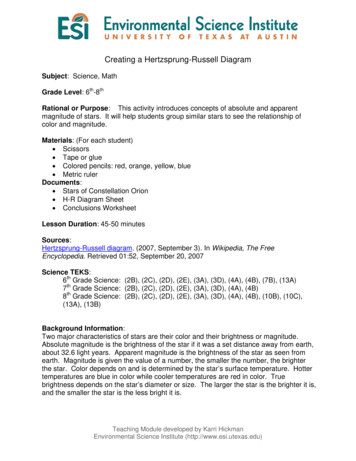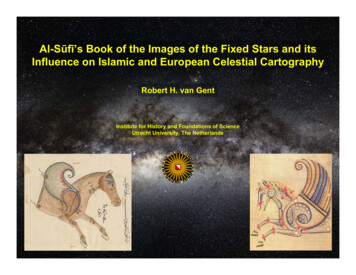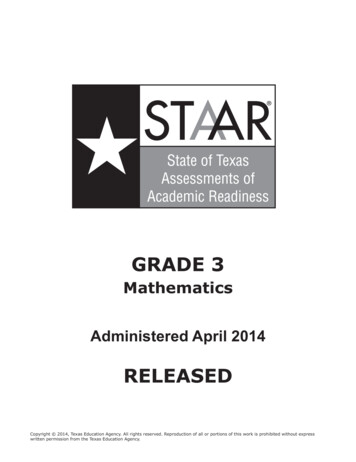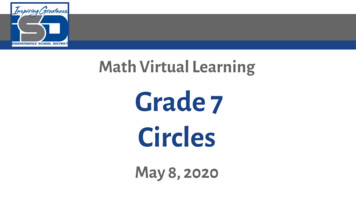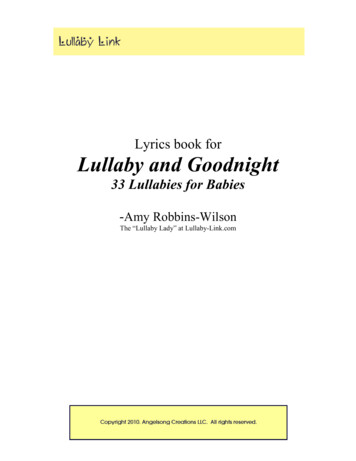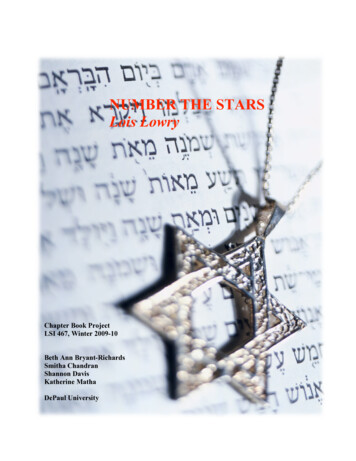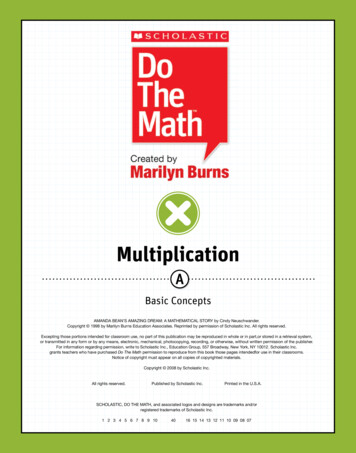
Transcription
MultiplicationABasic ConceptsAMANDA BEAN’S AMAZING DREAM: A MATHEMATICAL STORY by Cindy Neuschwander.Copyright 1998 by Marilyn Burns Education Associates. Reprinted by permission of Scholastic Inc. All rights reserved.Excepting those portions intended for classroom use, no part of this publication may be reproduced in whole or in part,or stored in a retrieval system,or transmitted in any form or by any means, electronic, mechanical, photocopying, recording, or otherwise, without written permission of the publisher.For information regarding permission, write to Scholastic Inc., Education Group, 557 Broadway, New York, NY 10012. Scholastic Inc.grants teachers who have purchased Do The Math permission to reproduce from this book those pages intendedfor use in their classrooms.Notice of copyright must appear on all copies of copyrighted materials.Copyright 2008 by Scholastic Inc.All rights reserved.Published by Scholastic Inc.Printed in the U.S.A.SCHOLASTIC, DO THE MATH, and associated logos and designs are trademarks and/orregistered trademarks of Scholastic Inc.1 2 3 4 5 6 7 8 9 104016 15 14 13 12 11 10 09 08 07
OVERVIEWIntroduceMultiplicationThrough the game of Circles and Stars, students learn howmultiplication can be thought of as combining equal groups.Lessons1–5Introduce MultiplicationTM & Scholastic Inc. All rights reserved.
FROM MARILYN BURNSDear Colleague,ars.e game of Circles and StthhugrothntioicaplmultiLessons 1–5 introducethem withto teach, and providessyeas,ntdesturfongtion.The game is engagiderstanding multiplicaunrfotexntcoalsuvidafirsthand experience anny circlescube to find out how maermbnu61–allrosntinOn each turn, studehow many stars to drawtoudfintonaiagbee cuto draw and then roll th3, the student4 and a second roll ofofllrostfirarfoe,pleach circle. For examwould draw this:In Lessons 1–5,students Represent combiningequal groups withrelated addition andmultiplication equations.TM & Scholastic Inc. All rights reserved. Communicate ideas withkey math vocabulary:equal, multiplication,multiplication equation,and times.2Introduce Multiplicationturns,they drew. After sevenrsstanymawhotoueStudents then figurdrew more stars in all.players figure out whoplications understand that multintdestuslphesarStdd toPlaying Circles anand is, therefore, relatepsougrluaeqgininmbcan be thought of as coplaying,d multiple times. Fromdeadisermbnumesa 6.addition when thembers from 1 1 to 6nungyiplltimuthwirliastudents become famien they roll ammutative; that is, whcoisntioicaplltimuatll a 3They also learn thof stars as when they roermbnumesaethtgeey4 first and then a 3, thfirst and then a 4.
Lessons 1–5introduce multiplicationby engaging studentsin playing the game ofCircles and Stars.Lessons1–5After students know how to play the game, they learof their turns witn to represent eah addition and mchultiplication equations.connect the standaThishelps themrd symbols to their experience andconnection betweealso strengthens thn addition and meultiplication. Students also learn to play Circles and Stars Capture, areinforces studenrelated card gamt understanding we thathile providing consistent practice.TM & Scholastic Inc. All rights reserved.StarsdnasCircleIntroduce Multiplication
PLANNERA:HHDC &A:HHDC 'Lesson SummaryStudents learn how to play themultiplication game Circles and Stars,focusing on drawing and combiningequal groups of stars.Students learn how to write and readaddition and multiplication equationsfor Circles and Stars.Objectives Combine equal groups. Represent combining equal groupsFind an alignment to standards atwww.scholastic.com/DoTheMath Communicate ideas with key mathvocabulary: multiplication.with related addition and multiplicationequations. Introduce key math vocabulary: equal,multiplication, multiplication equation,and times. Communicate ideas with key mathvocabulary: equal, multiplication,multiplication equation, and times.MaterialsT Teacher BagG Games BagS Student BagBuilt-inDifferentiation WorkSpace pages 2–5 number cubes (1–6) TSThe muliplication game Circles and Starspresents visual representation ofmultiplication as repeated addition,providing a clear introduction to the ideaof equal groups. WorkSpace pages 4–6, 61 Do The Math Community News paper chartThe routine of writing related additionand multiplication equations for eachturn of Circles and Stars reinforcesthe relationship between addition andmultiplication.Teaching Arithmentic:Lessons for Introducing Multiplicationby Marilyn Burns, pages 11–224Introduce MultiplicationTM & Scholastic Inc. All rights reserved.
A:HHDC (A:HHDC )Students learn that the samenumber of items can berepresented by differentequal groups.Students work in pairs to writemultiplication equations for achart. Represent combining equal groups Represent combining equal groupswith related addition andmultiplication equations.A:HHDC *with related addition andmultiplication equations. Communicate ideas with key mathvocabulary: equal, multiplicationequation, and times.vocabulary: equal, multiplicationequation, and times.TM & Scholastic Inc. All rights reserved. Represent combining equal groups Communicate ideas with key mathvocabulary: multiplication equation.GWorking in pairs provides studentstime to practice the language to expresshis or her ideas before communicatingthem to the whole group.TeacherSpace: Multiplication DVDcontains videos, professional articles, andreproducibles to support teaching these lessons.Students demonstrate understandingof the objectives for Lessons 1– 4by completing WorkSpace pagesindependently. WorkSpace pages 8–12 Circle and Stars Capture cardsGAssessing with familiar visual modelsand symbolic representations allowsstudents to show their understandingwithout having to approach the materialin an unfamiliar context.Lessons1–5Introduce MultiplicationRegularly reading aloud themultiplication equations usingthe terms groups of and equalsreinforces the concept and thelanguage used to express them.G WorkSpace page 7 Circles and Stars Capture cards Multiplication Equations chart blank paper Progress Monitoringwith related addition and multiplicationequations. Communicate ideas with key math WorkSpace page 7 Circles and Stars Capture cards chart paper6HH:HHB:CI
A:HHDC & Learning the Circles and Stars multiplication gameL DA: GDJELesson SummaryStudents learn how to play the multiplicationgame Circles and Stars, focusing on drawingand combining equal groups of stars.STEPObjectives Combine equal groups. Communicate ideas with key math vocabulary:multiplication.1Introduce the lesson. Today, you’ll play Circles and Stars, a game that will helpyou learn about multiplication. But first, I am interested inwhat you already know about multiplication.Write multiplication on the board.Materials WorkSpace pages 2–5 number cubes (1–6) T1Initiate a discussionabout multiplication.SMULTIPLICATIONT Teacher BagS Student BagKey Math ónAcademic Vocabulary2Students share prior knowledgeabout multiplication.Point to the word multiplication on the board and readit aloud. What do you know about multiplication? What totalturnturnoCognates are shown in italics; pointing out the similarityof these words to their English equivalents will help yourSpanish-speaking students acquire math vocabulary.come to mind when I say multiplication.Have students think, pair, share.HJEEDGI C CHIGJ8I DCThink, pair, share is a routine that will be usedthroughout this module. Having students talk inpairs provides them a “safe” way to share ideasthat they may not be quite sure of, think of words toarticulate their ideas, brainstorm, and practice whatthey will say when they share with the larger group.Explain the routine to students: they should thinkfirst and then talk with their partners, taking turnslistening and speaking, and finally discussing whatthey will say when they are called on to share withthe whole group.6Introduce MultiplicationTM & Scholastic Inc. All rights reserved.Language Development
Next Lesson Students learn howLesson & Students learn how to play amultiplication game.L DA: GDJEL DA: GDJE1Teach how to play amultiplication game.Demonstrate a turn ofCircles and Stars.31To play, a player rolls a number cube to find outhow many circles to draw, then rolls the cube againto find out how many stars to draw in each circle.The player then writes how many stars in all.Draw 2 circles on the left side of the board. Now I roll again. Suppose I roll a 4. I draw4 stars in each circle.Draw 4 stars in each of the 2 circles.Walk students through the firstproblem on WorkSpace page 2. The first roll is 3. What do you draw? (3 circles)The second roll is 2. What do you draw?(2 stars in each circle)How many stars did you draw in all? (6 stars in all)Write 6 in the How many? box.2Continue to guide students as theycomplete WorkSpace page 2. LDG@HE68: E6 : 'Circles and Stars Practice Turns How many stars did I draw in all? (8)Write 8 to show how many stars in all.9 G:8I DCHRoll 11224Choose a student to demonstratea turn.3Howmany?Roll 2Draw circlesfor the first roll.544Draw s in each circlefor the second roll.1Ask a student to draw circles and stars on theboard just like you did. The first roll is 3 and thesecond roll is 5.Roll 122143Roll 2241Howmany?1Roll 2663 5345123 2Howmany?Lesson 1151 12Roll 135Howmany?4Roll 1Roll 2 Write the totalnumber of s.2Roll 112211TM & Scholastic Inc. All rights reserved. I’ll show you how to play. On my turn, I roll thenumber cube and draw that number of circles.Suppose I roll a 2. I draw 2 circles large enoughto fit up to 6 stars in each.Guide students throughfour practice turns.STEPRoll 215 42STEPto write and read addition andmultiplication equations.Howmany?4Home Note: Your child draws equal groupsof stars and finds the total number of stars.CONTINUELesson 17
continuedA:HHDC & Learning the Circles and Stars multiplication gameL DA: GDJE4STEP DL ID EA6NBjai ea XVi dc VbZExplain the rules for acomplete game.Circles and StarsUse the rules shown to the right to explain.L]Vi ndj cZZY Draw simplified versions of WorkSpace pages 3and 4 on the board.0LAYER !0LAYER " number cube (1–6) WorkSpace pages 3 and 4 or blank paper pencilÜ Players take turns. Each turn hasfour steps.21Roll. Draw that many circles.241Students demonstrate acomplete game.52Choose two students to play a game of eight turnseach. Record the results on the gameboards youdrew on the board.After each player completes a turn, ask the otherplayer to check the work.When the students complete eight turns each,explain how to figure the total.Roll again. Draw that manys in each circle.3Howmany? Now each of you writes your total. Your total isthe number of stars you drew for all eight turns.The player with the greater number of stars wins. Write the total number of s.415 4Hand the cube to the other player.Ü The winner is the player who gets themost s in eight turns.8Introduce MultiplicationTM & Scholastic Inc. All rights reserved.141Two students demonstratea complete game.
E6GIC:GH5Partners play the game.STEP1Partners play a game onWorkSpace pages 4 and 5.2Remind students that an important part of theirjob is to check their partner’s work.Partners play again.If students have time, they may continue playingCircles and Stars on blank paper. The rules aregiven on page 3. LDG@HE68: E6 : * LDG@HE68: E6 : )Circles and Stars Multiplication Game DL ID EA6N56Ü Players take turns. Each turn has four steps.25134TM & Scholastic Inc. All rights reserved.Howmany?Roll. Draw thatmany circles. Write the totalnumber of s.Roll again. Draw thatmany s in each circle.15 414142Hand the number cubeto the other player.Howmany?Howmany?Ü The winner is the player who gets the most s in eight y?4TM & Scholastic Inc. All rights reserved.TotalHowmany?Home Note: Your child practices writingand solving multiplication equations.Lesson 1Lesson 15HJEEDGI C CHIGJ8I DCObserve students as they work.EXAMPLE The number ofcircles should match thenumber of the first roll.1EXAMPLE The number of starsin each circle should match thenumber of the second roll.Howmany?15 EXAMPLE How many? shouldmatch the total number of stars.STOPLesson 19
the number of stars you drew for all eight turns. The player with the greater number of stars wins. Circles and Stars L]Vi ndj cZZY number cube (1–6) WorkSpace pages 3 and 4 or blank paper pencil Ü Players take turns. Each turn has four steps. 1 2 4 Roll. Draw that many ci
